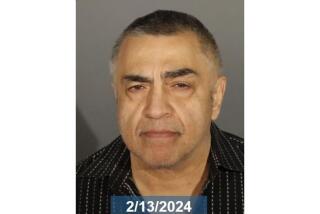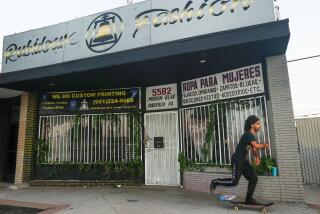Ex-Real Estate Broker Guilty in Chatsworth, Newhall Land Swindle
- Share via
A federal jury Tuesday convicted former Orange real estate broker Gerald Ramos of taking part in a swindle of $21 million from financial institutions nationwide in a scheme involving property in Chatsworth and Newhall.
Ramos, 38, a flamboyant deal-maker who once tried to cash checks for $750,000 of the money at a casino and who fled to Spain for a year, smiled as the verdict was read.
“This verdict should show the real estate people who play fast and loose with the rules what can happen to those who go beyond what is proper and legal,” said Guy N. Ormes, special assistant U.S. attorney and an Orange County deputy district attorney.
Ramos faces a maximum of 170 years in prison for the scheme that used inflated land values, false financial statements and worthless mortgage insurance to gain millions in loans. The loan proceeds were not repaid but were split among partners, with Ramos getting $3 million, according to Ormes.
Chatsworth Land
At the center of the criminal case is a 440-acre tract of land near Chatsworth that Ramos and partner John Chodak of Laguna Hills arranged to buy for $1.05 million in early 1984. They paid an appraiser from Huntington Beach $10,000 to estimate the value of the property at $18 million.
It was what Ormes described to jurors as a “cranked deal,” designed to justify a maximum loan with no intent to repay.
Ten businessmen, most from Orange County, originally were charged in the scheme. Eight have been convicted, one was acquitted by a judge, and one awaits trial.
Ramos was known for his aggressive approach to business and for his profane language, according to testimony at the trial.
The former Orange resident fled shortly before his indictment was returned in 1986, and he remained a fugitive until wiretaps on his relatives’ telephones lead to his arrest in a town in Northern Spain last year.
Ramos Defense
Ramos’ lawyer, Paul E. Potter, presented no evidence. He contended that the government failed to prove the case against Ramos, whom he portrayed as a tough businessman who was “sucked in” to a fraudulent scheme and who was manipulated by others. Ramos, according to Potter, was in “way over his head” in a complex deal to develop two properties.
But prosecutor Ormes pointed to Ramos’ extensive involvement, from actually buying the properties to obtaining the appraisal of the 440 acres near Chatsworth that inflated the value of one from $1 million to $18 million. Ramos also took $3 million as his split without making any payments on the loans, Ormes said.
Jurors convicted Ramos of fraud and interstate transportation of stolen property. He was found with $750,000 in cashier’s checks, several of which he had tried to cash at an Atlantic City casino.
Critical to getting a loan on the property near Chatsworth was a financial guarantee bond from Glacier General Assurance Co., a now-bankrupt Montana insurer run by Santa Ana businessman John Hayden. Hayden, who has also been implicated in the massive Bank of America fraud, is awaiting trial. (Bank of America lost $95 million in 1984 to a scheme involving inflated appraisals, bogus and fictitious loan applications and worthless financial guarantee loans.)
The Glacier bond appeared to eliminate all risk to lenders in the transaction. But because Glacier was near insolvency at the time, the bond was in fact worthless. To get it, Glacier’s Southern California representative, the late John Wain, ordered Ramos and Chodak to take on a partner and a new development tract, near Newhall. That partner owed Wain money, and Wain hoped to recoup it by including him in this plan.
21 Banks Involved
Ultimately, two loans were issued by 21 Midwestern and Eastern banks totaling $21 million on both properties. But the Chatsworth tract was rugged and inaccessible, and a housing project there was impossible, according to Ormes. Investors were tantalized by promises that a 300-room hotel would be built in Newhall in time for the 1984 Olympics, but the land was in a flood plain and that project was impossible, according to the prosecutor.
The developers defaulted on both loans without making a single payment, the government charged.
The chief witness in Ramos’ trial was Chodak. He, like Ramos, received $3 million from the loan proceeds. He was the first defendant to cooperate with prosecutors and the first to plead guilty.
Also testifying for the government was Marvin Weiss, a Los Angeles businessman who was sentenced to three years in prison for his part in the Chatsworth swindle and four years in the Bank of America fraud. Weiss was also ordered to pay the Bank of America $10 million as restitution in that case.
Witness Against Ramos
Bruce Furst of Orange, a loan broker who helped arrange the financing, also testified against Ramos. Furst, who got $4 million in the swindle, is serving three years in prison.
Others convicted in the scheme were Michael Fairbanks, 29, of Anaheim, a loan broker; Leo Peterson, 65, of Huntington Beach, an appraiser; David Techak, 37, of Anaheim, Chodak’s assistant, and Charles Mobley, a Los Angeles appraiser, who was also implicated in the Bank of America swindle.
Hayden, still awaiting trial, allegedly received $3 million from the Chatsworth swindle, and all other defendants received a total of $3.76 million, according to Ormes.
The only defendant acquitted in the first trial last year was developer John Ward, whom Ramos accepted as a partner as a condition of receiving the financial guarantee bonds.
Wain’s Death
After the verdict was returned in U.S. District Court, jurors were particularly interested in what happened to Wain, Weiss’ partner who made the key decision to issue the Glacier bonds. The guarantee bonds, one developer testified, turned financing “from a headache to a snap.”
Wain died an apparently natural death, Ormes said. Due to his short illness and the quick cremation of his remains, federal investigators were at first skeptical. But an extensive investigation turned up no evidence that Wain faked his death, Ormes said.
The jury deliberated two days before convicting Ramos. He declined comment as marshals lead him from the courtroom. Potter said an appeal is possible.
U.S. District Judge Harry L. Hupp, who presided over the trial, will sentence Ramos in August.
More to Read
Sign up for Essential California
The most important California stories and recommendations in your inbox every morning.
You may occasionally receive promotional content from the Los Angeles Times.









